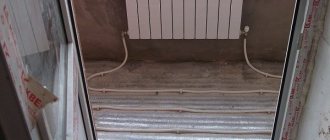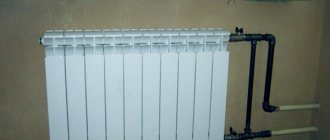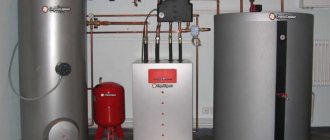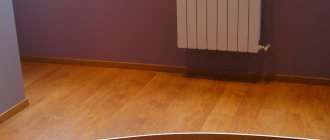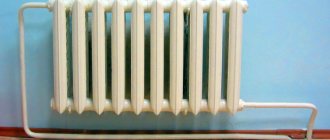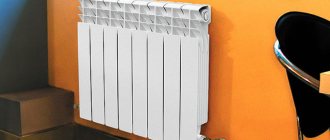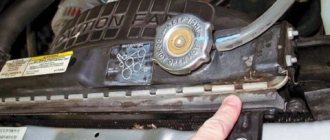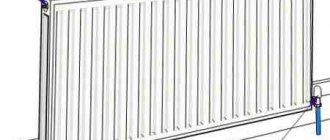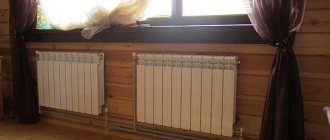Calculation of power, number of sections
Before choosing a heating radiator for an apartment, you need to calculate how many sections should be installed in each specific room and determine the power and pressure rating of this device. This is done as follows:
Selecting radiator power
In this case, the following points must be taken into account:
- Type of building (brick or panels).
- The area of the heated room.
- Number of windows.
- Presence of external walls.
- Type of glazing in the apartment (double glazing or wooden windows).
According to the standard, in a room with a ceiling height of 3 m, having one window with a wooden frame and one door, a radiator with a power of 90-125 W per 1 m2 is usually installed.
Useful information: To select a battery of optimal power for a room, for ease of calculation, you need to multiply its area by 100 W.
If there is one window and two external walls, this figure must be increased by 20%.
If there are two windows and two external walls - by 30%.
When the window is located on the north or northeast side: + 10%.
When placing the radiator in a niche: + 5%.
If there is a continuous screen on the battery: + 15%.
Deciding on the number of sections
Average power of a radiator section of various types:
There is another option for calculating how to choose the number of sections of a heating battery so that it is comfortable in a heated room, which is considered more accurate. This calculation is also made taking into account their heat transfer. In this case, the unit of space is not the area of the room, but its “cubic capacity”, that is, the volume of air mass that is to be heated. Each room is calculated separately: first, the power of the heating device is selected, and then the number of its sections is calculated.
Considering that to heat 1 m 3 of air space in a living room, 39-41 W of energy is needed, in order to heat a room of 10 m 2 with a ceiling height of 3.0 m, 1230 W are needed.
- We calculate the cubic capacity: 3 x 10 = 30 m3.
- We determine energy consumption: 41 x 30 = 1230 W.
Let's agree that each section of a modern heating battery produces approximately 200 W of energy. That is, to calculate the optimal number of sections you need 1230:200 = 6.15 sections. Round up. It turns out that in a room with a cubic capacity of 30 m 3 you need to install a radiator with 7 sections.
Useful information: When installing a battery in a corner-type room, a heat loss coefficient (1.1-1.3) is added to the formula for calculating the number of sections, the value of which must correspond to the climatic zone. The result will be: 1230·1.3:200=7.995. That is, for such a room a radiator of 8 sections is suitable.
Understanding working pressure
When purchasing heating radiators, you need to take into account their operating pressure, which should be higher than the pressure of the heating system at home
This is especially important when conducting hydraulic tests, when the load on the system is especially intense. For different types of batteries it has its own meaning:
- For cast iron - 6-12 atm.
- For aluminum ones - 16-20 atm.
- For bimetallic ones - 35 atm.
- For steel ones - 6-10 atm.
We have a separate article about the need for an expansion tank in the heating systems of private houses, as well as about its installation.
Preparation for installation
Preparatory activities include several mandatory steps.
Radiator selection
You need to choose the type of radiator based on its technical characteristics , the most important of which is operating pressure. It must comply with the pressure drop limits in the heating system of the house. As a rule, in old five-story buildings the value of this indicator is 6–8 atmospheres, and in multi-story buildings (10–14 floors) the pressure level reaches 12–15 atmospheres.
The second important indicator is resistance to water hammer . The service life of the radiator and the quality of heating depend on this characteristic. With a centralized heating system, it is almost impossible to avoid water hammer, so when choosing equipment you need to pay attention to this technical characteristic. Additional important factors include lifespan, ease of installation, and heatsink design.
Types of radiators
Types of batteries and radiators are divided according to classes and materials of manufacture:
- Cast iron. They have the longest service life (up to 35 years). The main disadvantage is the long heating and cooling time.
- Steel panel. They will last about 15 years. They are valued for their high heat transfer rates and other technical characteristics, as well as their low cost.
- Tubular steel. They are available in a variety of colors and designs, allowing you to match them to any interior. They have excellent consumer properties. The disadvantages include high cost.
- Aluminum. Average service life is 15 – 20 years. They are characterized by high thermal conductivity and low weight. The main disadvantage is the sensitivity of the filler to the PH, therefore they are recommended for private houses with an autonomous heating system.
- Bimetallic. The best option for an apartment, as they are unpretentious in terms of the composition and quality of water, have good heat transfer, and are resistant to water hammer.
We recommend: Wedge forests: features
Calculation of the number of sections
All types of radiators are composite, so you can select the number of sections needed to heat a particular room, depending on the area.
The calculation must be made on the basis of generally accepted standards:
- one aluminum section per 2 m2;
- one bimetallic section per 1.5 m2;
- add 1-2 sections for reinsurance.
Selecting a connection option
You can consider the following connection methods:
- Side. The most common installation method. The inlet and outlet pipes are mounted on one side of the radiator. The main requirement is to maintain the distance between the fittings, otherwise the radiator will not warm up sufficiently.
- Lower. With this option, both pipes are mounted at the bottom of the radiator - inlet on one side, outlet on the other. The main disadvantage is low heat transfer.
- Diagonal. The input is mounted on top on one side of the radiator, and the output is mounted on the bottom on the other. With this method, the least heat loss is achieved, so it is considered the best.
Which pipes to choose
For work , it is recommended to choose reinforced polypropylene pipes because they :
- easy to bend, allowing installation of any complexity;
- do not deform during operation;
- do not require welding - flux is applied to the joints and sealed with a special blowtorch;
- have a high heat transfer coefficient.
It is possible to use copper pipes, but this is a more expensive and difficult to install option. Ordinary propylene quickly deforms and loses its attractive appearance.
We assemble, install, connect the radiator
The process of assembling and installing the radiator is not complicated, but it requires special tools and equipment. Think about it, maybe it’s worth contacting a specialized organization.
The best option is to enter into an agreement for the installation of radiators with the management company. They will install heating radiators in the apartment in accordance with the rules, carry out pressure testing and sign an acceptance certificate for operation.
For those who decide to work on their own, here are some tips on preparing and installing the heater.
- Do not forget to bleed any remaining water from the system.
- Disconnect the old battery.
- Inspect the condition of the radiators, remove the cellophane packaging, remove the protective film from the threads, if any.
- Open the universal battery connection kit. The kit is selected with threads according to the diameter of the supply pipelines. As a result, there should be: two fittings with right-hand threads, two fittings with left-hand threads, two American ones with nuts, two taps, a plug, a Mayevsky tap, brackets or strips for attaching batteries. The internal thread standard is 3/4 inch, right-handed throughout. This is what you need to install a heating radiator in an apartment from the minimum standard configuration.
- Remove the silicone gaskets from the fittings and screw them into the radiator to check the threads. If there is no gap left, unscrew the fittings and install gaskets. There is a gap - check, clean the threads, there may be a protective film left.
- Separately assemble the connections: fitting + American + tap for supply and return, fitting + plug, fitting + Mayevsky tap. The connections are mounted on fum tape or tow. There are gaskets on the plug and the Mayevsky tap, no tow is needed. Pull connections.
- Screw the assembled kits into the radiator, do not forget to put silicone gaskets on the fittings. The battery is ready, you can install it. Place the heater in the designed position and temporarily connect it to the pipelines. If installation is being carried out to old pipes, the holes of the new radiator must be coaxial with the old battery, the common standard is 500 mm.
- Mark the top of the heater, mark the mounting locations for the brackets. Remove the battery, mount the brackets, and install it back. The radiator should have a slope of 2-3 mm away from the Mayevsky tap, strictly vertically, and rest firmly on the brackets. Check the level. All that remains is to connect to the pipelines.
Follow the rules for installing heating radiators in the apartment described above. After installation is complete, call a representative from the management company for pressure testing and signing the acceptance certificate. This is an important stage of final work.
Video:
Video:
Battery removal procedure
It is important to remember how to properly remove the terminals from the battery. There is a certain order of actions that must be followed
At the same time, do not forget about safety precautions. The sequence of actions is as follows:
- First you need to turn off the car.
- Turn off all electronic devices.
- Close windows and doors: if the car has power windows, after removing the battery, the windows will not be able to be raised. The doors will have to be closed manually with a key.
- Remove the cover protecting the battery terminals from dust and dirt.
- If there is no cover, you need to insulate the positive terminal with electrical tape.
- Remove grounding, if present.
- Loosen the nuts with a wrench.
- Disconnect the negative terminal, then the positive one.
- Do not allow the positive terminal to come into contact with metal objects.
The car body, also called the ground, is connected to the negative terminal. When it is removed, the circuit is broken and a short circuit cannot occur, since the battery is disconnected from the body.
Thus, removing the terminal from the battery is easy. You just need to strictly follow the sequence of actions.
Which heating batteries are better for an apartment?
Radiators differ in heat transfer level, service life and price. The determining factor in the quality of the installation is the material of manufacture. The most popular types of heating batteries in an apartment are:
The operating principle of the design is simple. The main coolant is hot water. The connection is made through a pipe. Under the influence of heat, the surface of the installation begins to heat up, and the room temperature begins to increase. Depending on the material and design of the panels, water radiators cool faster or slower.
In cast iron installations, hot water enters from one side and exits from the other. To carry out such work, a large amount of coolant is required. The operating principle of steel, aluminum and bimetallic heat exchangers has a slight difference. Inside each section there is a thin tube that is filled with hot water. Thanks to the air cushion that forms inside, the thermal conductivity of such batteries is higher. To start the system you only need 350 g of water, which simplifies installation.
To understand which radiators are best suited for heating an apartment, it is worth familiarizing yourself with the main characteristics of each type. The battery - a universal installation for heating commercial, industrial and residential buildings - has its own characteristics depending on the material of manufacture. By comparing the pros and cons, you will find the best option.
Bimetallic radiators
The devices are made of steel and aluminum. The installation is very durable and has high thermal conductivity. The attractive appearance of the batteries makes them the best option for the office or home. The system is a structure of vertical steel tubes, which are coated with aluminum on the outside. This heat exchanger is corrosion resistant and durable. If you don’t have enough temperature, you can always attach another section to the bimetallic battery.
Aluminum
The units are distinguished by high heat transfer and attractive design. Compared to the previous option, their price is more affordable. If you are interested in replacing heating radiators in apartments, the aluminum option is perfect. They are easy to install. Batteries are installed in autonomous and central heating systems. For more economical energy consumption, it is recommended to use thermostatic valves.
If you don’t know which radiators are best for central heating, then choose this option. The design is ideal for a cyclic heating system. The installation is reliable and will last for many years. The disadvantages include relatively low heat transfer and rapid cooling of systems. It is very bulky, so it requires special skills to install. Such heat exchangers are inexpensive, which makes them very popular.
Affordable and practical systems remain in demand to this day. They are installed in cottages, apartments, and commercial premises. The degree of heat transfer is very high. If the system power is incorrectly calculated or the coolant temperature is low, the solid iron structure can become a problem. It is impossible to modernize it, so you will have to change the entire structure. The cost of steel batteries is low.
How to hide batteries in a room? Original ideas, photos
To hide a battery in a house or apartment, it is not necessary to organize a major renovation or large-scale redevelopment; it will be more economical to choose a couple of new design ideas and solutions that use modern experience in this area, and special finishing materials.
The most popular method for masking batteries
Sheathing a wall with plasterboard is often used to achieve this goal (to hide the battery). However, this method has both pros and cons. This is done easily, quickly and cheaply, but it visually reduces the area of the room. Having practical experience and knowledge about working with drywall, such a solution can be implemented independently; otherwise, masking the battery will turn into a long and painful independent work.
Hidden heating radiator under drywall.
We should not forget that if the heating devices are tightly closed, the heat will not pass through, so this is not recommended. To solve this problem, holes are cut out in the material, which ensures the necessary air circulation. For a better aesthetic appearance, decorative screens are installed on top of the drywall, which makes radiator maintenance easier in the future.
Special screen
Another advantage of using drywall is the ability to hide the pipes that lead to the radiators. However, this solution is more relevant when performing renovation work on the entire room, since this involves covering the entire wall with the material.
The easiest way to hide a battery in a room with your own hands
It is much easier and more economical to use a hanging screen. There are a large number of different models and alternative options for any interior in this area, for example:
- hinged screen with cover;
- screen boxes;
- metal screens;
- wooden screens;
- glass screens;
- MDF screens.
The advantage of hanging screens is that they can disguise batteries, regardless of the age of renovation in the room or any other factors. To install such models, it is not necessary to have special knowledge or put in a lot of effort, because the installation process involves simply hanging them on the battery.
We check which radiators are suitable for residential heating
Batteries made of steel - fell, attacked by high pressure
Steel radiators are lightweight and thin. Good heat transfer and small volume of water make them economical and efficient. Yes, and they are inexpensive. But in terms of pressure they “let us down” - they can withstand only 6-8 atmospheres. They are not suitable for apartments, period.
Aluminum radiators - are eaten by corrosion, burst from water hammer
These radiators look nice, and 190 watts of thermal power pleases the consumer. However, wait, apartment dwellers – it’s too early to rejoice. Hot water with chemical impurities and high acidity quickly “eats” batteries from the inside. After all, aluminum is too active. And he can't cope with a lot of pressure. Average operating pressure is up to 16 atmospheres. And water hammer can destroy even a brand new aluminum radiator.
Bimetallic batteries are good for everyone, just expensive
This is one of the newest developments in heating devices. Such radiators are called bimetallic - after all, they contain two metals. This can be, in particular, aluminum and steel, or aluminum and copper.
Manufacturers guarantee that such batteries will work for at least forty years. They are suitable for an apartment in all respects, as you can see.
- They can withstand temperatures even up to 130 degrees.
- Their operating pressure is stated to be up to 30 - 50 atmospheres, depending on the manufacturer and model. With them you can stop being afraid of water hammer.
- Anti-corrosion external and internal primer makes the batteries durable and resistant to destruction.
- Light weight makes installation, carrying and transportation of such batteries easy.
Alas, not everyone can buy such an expensive device. And if they offer you something similar at an affordable price, don’t believe it. They will slip a fake. If you really buy, then buy products from trusted brands - the Russian company Rifar, Italian - Sira or Global. There are also good Chinese manufacturers. They, like Russian ones, have a slightly lower price than radiators from Europe.
Good old cast iron gets a second life
Fifty years, no less, is the life span of such a battery. In vain do some manufacturers of new products claim that it is high time to forget about this “old stuff”. Thinking for a long time about which heating radiators to choose for an apartment, many settle on cast iron radiators. They certainly won’t “play tricks” when they come into contact with dirty domestic water in the heating system. This metal is chemically passive, and it is not afraid of either high acidity or the presence of chemical additives in the coolant. And no abrasive will harm thick walls. So cast iron for an apartment (especially in an old house) is very good.
- Radiators made of cast iron are distinguished by the fact that they retain heat for a very long time - the residual value of its retention is 30 percent. And for all other types of batteries this figure is half as much
- Heat transfer due to the radiant heating method is much more effective than when using convection (as in bimetallic and aluminum products. Cast iron radiators heat not only the air, but also nearby objects.
- When draining water from the system in the summer, cast iron batteries will not rust - this is a significant plus.
- The large heat transfer area is another plus.
- Cast iron usually withstands pressure drops that central heating suffers from well. The operating pressure can reach up to nine to twelve atmospheres. But it doesn’t always withstand high-power water hammers - the fragility of this metal lets it down.
- The cost of these devices is usually lower than bimetallic radiators. Sometimes this is the determining factor.
These radiators are, of course, heavy, which causes some inconvenience during their installation. Well, yes, cast iron a priori cannot be light. But this weight results in large wall thicknesses, which give the radiators the required strength. Having installed cast iron radiators once (and this will be done by specially trained people - plumbers), you can forget about replacing them for many years.
The appearance of cast iron radiators today is no longer as poor as in Soviet times. Very attractive externally, figured cast batteries have appeared, made in a “retro” style, which harmonize very well with sophisticated rooms. For example, you can mention products from Roca and Konner.
True, the cost of such miracle batteries is quite high. Ukrainian, Russian and Belarusian models are more budget-friendly, many of which must be painted before use. But they also look quite decent, their design fits into the interiors of modern apartments.
What threats does centralized heating pose?
On the one hand, supplying heat from outside is more convenient than autonomous heating - you don’t have to bother with installing the boiler and setting it up. Autumn will come, and hot water will happily run through your radiators, warming your apartment.
But not everything is so smooth in the centralized heating system:
- Water that has traveled a long way contains many chemically active impurities that can cause corrosion of pipes and radiators.
- And small particles of sludge, which inevitably fall into the coolant, scratch the batteries from the inside, wiping them to holes after a few years.
- And the water temperature is not always stable - sometimes the batteries are at room temperature, or sometimes it’s impossible to touch them.
- And the most important danger is a sudden huge surge in pressure in the heating system, the so-called water hammer. It happens, for example, for the reason that the mechanic closed the tap of the pumping station too abruptly.
Previously, they used smooth-running valves, but with the advent of ball valves, it became possible to turn off the water instantly. Water hammer also occurs when excess air gets into the pipes. A second surge in pressure can cause a lot of trouble. Weak batteries cannot withstand enormous pressure and burst, splashing boiling water, ruining furnishings and causing damage to neighbors below.
In conclusion, we draw conclusions
Now it’s probably easier for you to decide which radiator to choose for your apartment - after all, out of the four options considered, there are only two left. As it turned out, neither steel nor aluminum radiators will withstand the test of either aggressive domestic coolant or pressure drops. So, what remains are bimetallic and cast iron appliances. What exactly to buy, look at your budget, as well as the characteristics of specific models. However, here you can give a couple of tips.
- In old houses (for example, “Khrushchev” buildings) it is quite possible to install cast iron products. If you live in a high-rise building, where the pressure of the heating system is higher, then it is still better to take bimetallic radiators.
- If the predecessors of your future new batteries are made of cast iron, then you can choose either of two options. Both bimetal and cast iron are suitable. If you are going to replace batteries made of another metal, then change them only to bimetallic ones.
